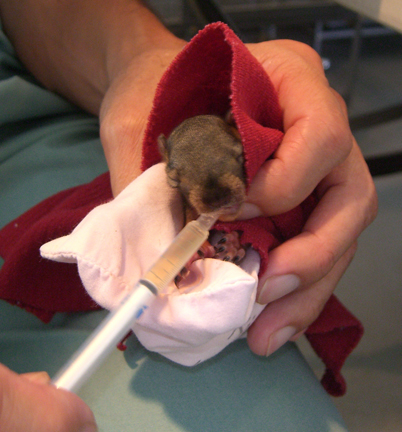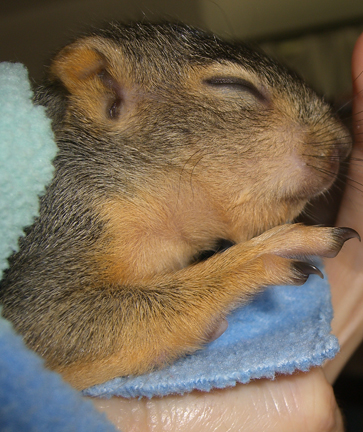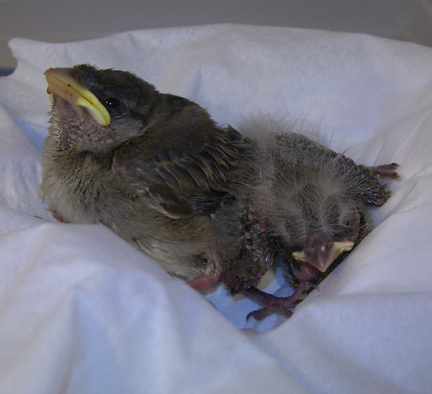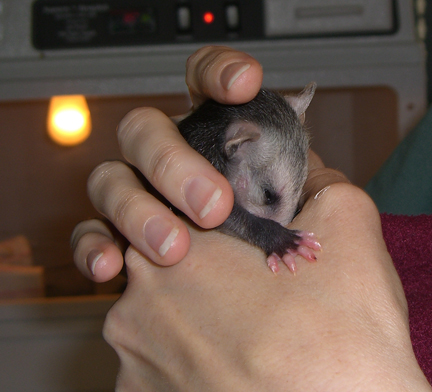Rehabilitating wild animals!
| Raising A Baby Squirrel I wrapped a soft fleece square around the docile baby squirrel and placed a small makeshift heating pad (a cloth sack of uncooked rice that I’d heated in the microwave) next to him. I gently wiped his bottom with a warm, wet cotton ball until he “rewarded” me with some yellow pee and a few pellets of brown poop. Then I pulled a small syringe filled with baby squirrel formula from a pot of warm water, placed a nipple on the end, and slid the tip into the squirrel’s mouth, gently offering the liquid to him as he swallowed. It was slow going. He was very young. |
 |
| The tiny squirrel had ended up at the wildlife center where I was volunteering because his nest had been disturbed by tree trimmers. If it wasn’t for a woman who'd found him on the ground and brought him to the center, he would have had no chance of survival. At the center, we fed him and kept him warm. |
 |
| Before long,
his eyes opened, his ears perked up and his tail began to
fluff. Soon he began to feed enthusiastically. We had to
carefully control how fast he sucked down his formula, so
that he didn’t aspirate (inhale the formula). His claws grew
sharp and his moves became quick. We had to catch him to
feed him. He was offered, and then weaned to, solid foods.
Then, he was moved to an outdoor cage. Finally, once he’d
grown big and strong (and very wild), he was placed in a
wooden box with a squirrel-sized door. The box was strapped
to a tree and he was released back into nature. It was cases like these that drew me to volunteer at the wildlife center. I grew up watching spunky squirrels collect nuts in my backyard. I’d always admired wildlife, to work with them up close was a privilege. Baby Bird Season When I started at the center, it was “baby bird season." The incubators were filled with many different species of birds of varying degrees of maturity. |
 |
| The youngest birds are
called hatchlings. Their eyes haven’t opened yet and they
have few, if any, feathers. Their skin is translucent. At
the wildlife center, they rest in "nests" of tissues
scrunched into plastic bowls inside temperature-controlled,
humidified incubators. They are fed a light brown pureed
concoction called MAC. MAC is made fresh at the
wildlife center by pureeing multiple ingredients in a
blender (to create a nutritionally-complete formula) until
they reach a goopy consistency. It smells like wet cat chow
and looks disgusting, but the baby birds thrive on it and
"beg" for more. Volunteers are taught to dip small plastic sticks into the mush and cue the baby birds to open their mouths. Most of the time, a cue wasn't really necessary. For most healthy baby birds, any nearby sound or movement resulted in enthusiastic chirps and wide open baby beaks. It amazed me to see tiny featherless birds open their gaping little mouths to me. I offered them formula while monitoring the tiny sac on the right side of their neck (called a crop), careful to give them just the right amount of food. The littlest birds need to eat every thirty minutes, so in busy baby bird season, I’d finish my feeding rounds and then start all over again. During the busy season, we’d often have multiple “nests” in one incubator. One time, when I returned to an incubator for a feeding, I found an empty nest. This didn’t surprise me. Young birds, once they get a little older, but before they learn to fly, hop out of their nests. In the wild, they find a safe place to hide and their mother feeds them there. I looked around the incubator for the missing bird but couldn’t find the baby anywhere. Then, I noticed that one of the nests that used to hold only one bird, now had two. A sparrow and a finch had become nest mates. The tiniest patients at the center are the hummingbirds. The youngest hummingbirds were challenging to feed. Like other species of birds, when they are very young, they open their mouths to their mother and she deposits food inside. In order to get the formula inside their incredibly tiny little mouths, we used intravenous catheters attached to small syringes. With a steady, careful hand, we slid the skinny tube into their tiny mouths and gently expressed minute amounts of formula. Once they grew a little older, the hummingbirds were much easier to feed. We filled red tipped syringes with hummingbird formula and decorated them with cloth “petals” to simulate a flower. When we held the syringes near the young birds, they eagerly slid their little beaks inside the syringe hub. Through the walls of the syringe, I watched the formula disappear as their skinny tongues extended from their beaks and lapped up the liquid. No Playing With the Possums My favorite babies were the Virginia Opossums. I loved how they would wrap their flexible little tails (contrary to popular belief, they do not hang from their tails) around my wrist as they gently licked drops of formula from the tip of a plastic syringe. As they got older, they would give their threat displays (open toothy mouths) to us when we reached into their cages at feeding time. An adult opossum doing a threat display does look pretty menacing, but the little ones look really cute. |
 |
| Still, they were wild animals and we were careful to keep
them that way. To prevent them, and all of the other animals
at the center, from becoming acclimated to
humans, we were not allowed to talk to any of the animals or to pet
or cuddle them. They were so cute that it was hard not to,
but if they were going to survive in nature, they needed to
act like wild animals, and that meant not seeking out human
contact. The Ones Who Didn’t Make It Unfortunately in wildlife rehab, some patients are too sick or injured to recover. I’ll never forget one night when a newborn squirrel was brought in who had fallen from a nest. After we’d let him warm up in the incubator, I gently lifted him out, covered him with a square of fleece and placed a heating pad next to him. I offered him the electrolyte solution given to all new admissions. He swallowed little drips at a time. As I fed him, fleas crawled from his body to mine. He had the most fleas I’d ever seen on one animal. His tiny head had a boggy bulge, a sign of a skull fracture. I reported my findings to the vet tech. She gave him some pain medication and told me to massage some flea powder into his fur. Hopefully these treatments gave him some relief in what turned out to be his final hours. Back To Nature There were many success stories at the center. A pelican with a torn pouch was brought in malnourished and dehydrated because he couldn’t feed effectively. We fed and hydrated him and the veterinarian repaired his pouch. A tiny baby duckling came in so weak that he was unable to lift his head. After some time in an incubator and some fluids, the little one perked up and flitted around happily. A baby barn owl was raised from a cute little ball of fluff into a beautiful adult. And many other baby birds and squirrels and opossums who were orphaned or injured were nursed back to health. The other day, a beautiful adult dove landed on my balcony. The bird stopped and looked at me and then flew away. A few minutes later, the bird returned. He cocked his head to the side and made eye contact for a minute, as if he were wondering something, then flew off. Was it a former patient? Maybe. |
I did this in 2009. |
|
ABOUT THE AUTHOR Jen is also known as J.W. Lynne, a best selling author of eleven novels. Click on any of the titles below to see the book on Amazon! THE UNKNOWN: Eight kids learn the shocking reason why they were kidnapped. ABOVE THE SKY: A girl lives in a world where touching her soulmate is forbidden. THE DARKNESS OUTSIDE: A teen is locked in a bunker to take a simulated trip to the moon. KID DOCS: An experimental program turns kids into doctors. WILD ANIMAL SCHOOL: A girl falls in love with a boy at an exotic animal ranch. WHAT HE DIDN'T TELL ME: A traumatized girl meets a boy with a horrible secret. IF I TELL: A teen wonders if her father is a serial killer. Besides reading books and dreaming up stories to write, Jen's favorite activities are singing along to musical theater soundtracks and hiking in California's beautiful parks. **Jen's books are available on Kindle Unlimited.** |
| What to do if you find a sick, injured, or orphaned wild animal |
If you spot a wild animal who needs help, call a wildlife rehabilitator immediately. She can give you advice over the phone and direct you to the nearest wildlife rehabilitator for the particular species of animal. If you have trouble finding a wildlife rehabilitator in your area, your local animal hospital or veterinarian's office may be able to direct you to one. Attempting to raise or rehabilitate a wild animal on your own can do the animal harm. At the wildlife center, we witnessed tragic cases of wild animals who were harmed by caring, well-intentioned people. For example, we saw young animals who had developed disabling permanent bone deformities because they were raised on a nutritionally-incomplete diet. Even if baby wild animals are fed a proper diet, no matter how much they are pet and cuddled, once the docile babies mature, their wild instincts make them the worst houseguests you can imagine, and if they are habituated to humans, they may never be able to be successfully reintroduced into the wild. |
